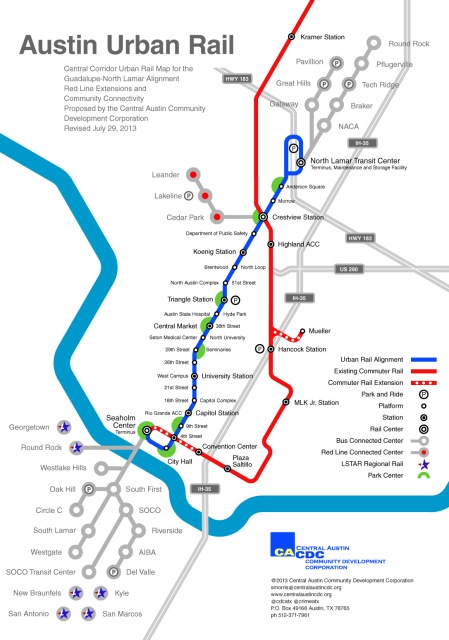
Another alternative urban rail plan for Guadalupe-Lamar corridor
9 September 2013
CACDC’s Central Corridor urban rail plan (blue), with MetroRail (red) and various bus links (grey). Map: CACDC
♦
Within the Austin community, momentum continues to grow to re-orient the officially promoted Urban Rail project (downtown-East Campus-Mueller) into a focus on the Guadalupe-Lamar (G-L) corridor as the primary spine for a Phase 1 (i.e., starter line) project. Much of this effort is coming from businesses, neighborhoods, and community groups within the G-L corridor itself.
Besides the “loop” proposal (one line through the G-L corridor, the other formed by converting the eastiside Red Line to electric urban rail) proposed a year ago by Texas Association for Public Transportation (TAPT), suggestions for other possible routes serving the G-L corridor are forthcoming from the community.
One of the most thoroughly developed is a 7-mile-long Central Corridor urban rail plan designed by the Central Austin Community Development Corporation (CACDC), led by Scott Morris (see map above).
From Crestview south to 4th St., the CACDC plan is virtually identical to the west branch of the TAPT “loop”, following Lamar and then Guadalupe. However, CACDC extends the line further up Lamar to the North Lamar Transfer Center, where it would provide connectivity to various bus routes at this major transit interchange, and then make a loop beneath the US 183 freeway to return south on Lamar. Also, at its southern end, it includes a spur east to the Seaholm development site.
The plan also proposes a short spur from the existing MetroRail Red Line (“commuter” light railway) into the Mueller development site. (The TAPT plan similarly includes an urban rail spur into Mueller from the eastside urban rail branch formed, as previously noted, by converting the Red Line to electric urban rail.)
Both of the CACDC urban rail extensions (the extension up Lamar and the connection to Seaholm) are similarly proposed by TAPT for a subsequent phase of urban rail development. However, if public and political sentiment can be shifted in the more rational direction of supporting an urban rail Phase 1 (starter line) route in this extremely heavy, productive G-L corridor, perhaps a “melding” of plans, incorporating the best features of these and other proposals, will be possible.
According to CACDC’s website, “This 7 mile phase one alignment serves the greatest number of riders, forms the expandable backbone of a much larger future system, and satisfies all public benefit criteria ….” The proposal also presents a long list of “communities, centers, and nodes” — almost entirely in the G-L corridor — that would be served
What the Austin-area public — especially voters — will prefer and accept can eventually be sorted out. What’s critical now is for all those who favor primary emphasis on the G-L corridor to work together to reallocate local planning focus away from the absurd downtown-East Campus-Hancock Center-Mueller non-corridor, and onto the G-L corridor — a real corridor (which also includes the fourth-highest residential density of all major Texas cities) — where it should have been in the first place, over the past 8 years of local planning.

Leave a comment